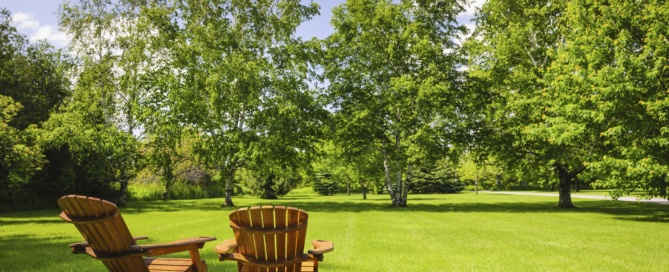There’s a lot to enjoy in the summer ? but there’s also a lot of work to do. When it comes to your trees, there are a few jobs you can do now to ensure a vibrant and healthy growing season and keep your trees strong going into the upcoming winter.
First things first ? inspect your trees.
Winter frosts and heavy snows can do a number on your trees. Inspect all of the trees on your property for damage, like winter burn. This happens when a tree does not receive enough moisture in the fall and cold winter winds dry out the leaf tissue. If you notice vertical cracks in the tree’s bark, you may be looking at sun scald, which can eventually lead to decay. Sun scald is more likely to be a problem with younger, thin-barked trees and occurs in the winter and spring months.
Additional signs of damage include abnormal leaf size, off-color bark and oozing sap. Any severely damaged or dead branches or trees should be removed.
Check for pests and diseases.
Unfortunately, trees are not immune from getting sick or overrun with pests. Insects tend to target vulnerable trees which are already weak from stress. Aphids are a common issue, notable for the sticky residue they leave behind after munching on tree leaves and stems.
The Emerald Ash Borer has caused devastating damage throughout most of the country. If you have Ash trees on your property, look for signs of dead branches starting at the top of the tree, and small D-shaped holes in the tree’s bark where the beetles exit in June. Trees with bad infestations may lose a third to a half of their branches in one year. The U.S. Forest Service operates an informative website on the Emerald Ash Borer, which you can find here.
Proactive care goes a long way in keeping your trees free from pests and diseases. If your tree has a bad infestation, it may need to be removed by a professional. Look for a certified arborist who meets the criteria of the International Society of Aboriculture.
Pick up the rubble.
Take advantage of the warm weather to pick up old leaves and twigs, fallen branches, or anything else that may be littering the floor of your landscape. Be especially careful to remove diseased material, and DON’T compost it; throw it in the trash.
Get out the pruning shears.
Now is the time to prune those dead or diseased branches you noticed in your inspection. Trees don’t try to repair or regrow injured or diseased wood; instead, they stop sending resources to the damaged tissue.
Pruning allows the tree to put energy into its healthy branches, it improves airflow and it can even lower the risk of insect infestation. If you are dealing with very large or very high dead branches, or branches that pose a risk to structures, vehicles or people, make sure you consult a professional first.
Feed your trees.
After a long, hard winter, trees are often desperate for nutrients. Help them recover and put their energy into new growth with a slow-release fertilizer. Healthy trees have the best defense against disease and insects.
Know how to water.
As the days become longer and hotter, it’s important to give your trees adequate moisture. Following a consistent watering schedule that mimics rainfall (a slow, deep soak) is the best bet. Established trees need one gallon (or one inch) of water each week and younger trees may need twice as much. Consider installing a drip line below ground and don’t water in the afternoon, when moisture can be lost to evaporation.
Apply new mulch.
Mulch provides so many benefits to your trees and can be a lifesaver in the hot summer. Add two to four inches of mulch around the base of each tree, being careful not to pile it up around the trunk (this is called “volcano mulching” and can kill your tree). In addition to retaining moisture and keeping soil temperatures cool, mulch provides added nutrients to the soil.
If the warm weather is calling to you, go ahead and answer. Dust off those gardening gloves and give your trees the attention they need to make it through the long summer.



Recent Comments